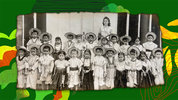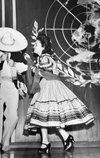
Maria de Lourdes Sotomayor Mehdi teaching in Mexico Photo courtesy of Yusuf Mehdi.
Today kicks off National Hispanic Heritage Month, a time of the year where we recognize the customs, legacies and achievements of the Hispanic and Latinx community in the U.S. This year it is an incredible honor for me to be an executive sponsor of the HOLA employee resource group at Microsoft, an amazing community of more than 4,000 members who are seeking to drive change inside and outside the company.
There are so many people of Hispanic and Latinx descent whose significant achievements are worthy of celebrating, such as Supreme Court Associate Justice Sonia Sotomayor; astronaut Ellen Ochoa; actor, singer, composer and playwright Lin Manuel Miranda; Dr. Antonia Novello, the first woman surgeon general of the U.S.; and labor rights leader Cesar Chavez.
Today though, I celebrate my mother, Maria de Lourdes Sotomayor Mehdi, who grew up in Mexico with her family before coming to the U.S. to start a new adventurous life with my father from India, Ishaque Mehdi, in the 1960s. She was teacher and a champion of many of our Mexican values and customs such as a fierce love of family, a curiosity and thirst for learning, and a passion for music and dance. Her impact was indelible for me and my sister, as well as the many students she inspired. Celebrating her is especially poignant for me as she just passed away a few weeks ago.
One of her loves was dancing and she’d teach Spanish to her students in the U.S. by occasionally coming to class dressed in a traditional Mexican dress and performing what is colloquially knows as the “Mexican Hat Dance” while explaining its history. I would never be able to muster the courage, nor the skill, to perform the dance, but I will share a bit of the history.
The “Mexican Hat Dance” is properly known as “El Jarabe Tapatio,” which is the national dance of Mexico originating from Guadalajara, Jalisco in the 19th century. The dance itself is intended as a representation of a courtship between two people, and the various elements of the dance signal the literal back and forth of the relationship. It begins with the “zapateado,” which involves the tapping and stamping of the foot. This element indicates one partner trying to impress the other. In the middle are steps that demonstrate a sort of “drunk in love” ritual. As things reach a head, one partner throws a hat to the ground, and when the other partner finally picks it up, the dream is fulfilled. After that, the couple marches in unison just like an army parade. This move is called “diana,” and it means that the couple has become one. The last element is a kiss behind the hat!

Maria de Lourdes Sotomayor Mehdi performing the El Jarabe Tapatio. Photo courtesy of Yusuf Mehdi.
As I reflect on this fond memory of my mother, it brings me closer to my culture and the things I am learning on my own journey of inclusion. The first of which is that my experience is only one of an incredible diversity of people, cultures and values that make up HOLA and what it stands for: Hispanic & Latinx Organization of Leaders in Action. HOLA represents 20 countries, all with their own unique traditions and values, a breadth of cultures and communities comprising people of various races, countries of origins, socioeconomic backgrounds and experiences. And what’s incredible is that the continually expanding HOLA community, like the broader Hispanic and Latinx community, impact all aspects of our society – from the workforce to the marketplace, to the innovations of tomorrow through the rapid growth of people working in all sectors of the economy. I’m excited to see how this rich and vibrant community can continue to influence our society and use “Our voz” (our voice) to make the world a better place.
This value of making space for everyone’s voice is something we champion at Microsoft, and it is a focus of my organization. We believe that we can only truly achieve our mission of empowering the world if we understand and represent the people of the world. That starts by listening and recognizing the uniqueness of people on our team and making space for them to have a say and a voice. A part of how I go about this I learned from my mother, which is to create that “family atmosphere,” a welcoming environment that creates the opportunity for all. I try and build that family ethos on our teams across Microsoft where our connections and our relationships and our values rise above any business project or problem. It’s not always easy, but as we progress on our journey, we are each finding the joy and the learning from our unique backgrounds, experiences and skills.
So, over the next month, I encourage us all to take time to reflect as either members of the Hispanic/Latinx community or as friends and allies to see how we can come together and build a brighter future. We are facing unprecedented challenges in the world today that we can only overcome when we embrace what makes us unique and focus on honoring every voice and working together for the greater good of humanity. HOLA is just one of the impactful employee resource groups and employee communities at our company, which includes Asians at Microsoft, Blacks at Microsoft, Disability at Microsoft, Families at Microsoft, GLEAM (LGBTQI+ at Microsoft), Indigenous at Microsoft, Military at Microsoft, and Women at Microsoft.
Together we can create great change, and I am committed to using my platform, influence and all of the resources I have to help these groups to build a brighter future for us today and for generations to come. In some small way, I hope that the thirst to learn about people and foster the family environment will honor my mother and what she stood for.
Learn more about what we’re doing for Hispanic Heritage Month
The post Honoring role models and raising our ‘voz’ this Hispanic Heritage Month appeared first on The Official Microsoft Blog.
Continue reading...